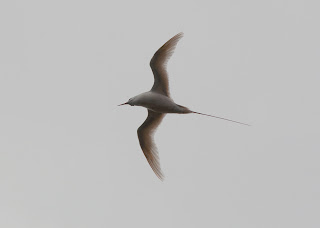The final bird photos from this particular day are of Tropicbirds, a bird I haven't had much of an opportunity to get decent closeup photos of during previous trips to Kilauea. There are two types of Tropicbirds that can be seen around the Hawaiian Islands: the Red-tailed and the White-tailed, both of which I had a chance to photograph on this particular trip. First up, some Red-tailed Tropicbirds:
As I've not yet mastered the intricacies of photographing white birds against gray clouds, I had to rely a bit on Photoshop to lessen the shadows on a few of these pictures. One of these days I'll figure it out...
The White-tailed Tropicbird is a bit more active and a bit more common at Kilauea Point. While their bodies and wingspans are a bit smaller than their Red-tailed cousins, their tails are actually a bit longer. They also have a yellow beak, rather than red, which helps when you're on your computer trying to figure out which ones are which a few hours later:
This one provides a better sense of the streamer-like tail these birds are known for:
Not the clearest shot, but I liked the contrast of the white bird against the cliff side:
The selections in this last group of photos aren't the greatest in terms of focus or overall clarity, but I thought they provided a decent look at the birds as they approach the cliff. White-tailed Tropicbirds set up their nests in rock crevices or burrows on cliff faces; in fact, very little is known about their breeding biology because their nests tend to be so inaccessible. While they usually breed from March to October, it appears that during our time there in early February they were beginning the nesting process, as a later look at my photos—specifically the way the tails of some of the birds are flared out—suggested to me that they were flying right up to the rock face, if not landing for a brief moment before departing again:
Finally, I even managed to snag some shots of a pair of birds that seem to have already picked out the perfect spot to raise their next baby:
In this last shot, the female bird's beak appears to be open—maybe she's reminding her mate to pick up the groceries on his way back home?
By the way, most of the info about these birds accompanying my posts comes from Hawaii's Birds, a book from the Hawaii Audubon Society that's been an invaluable resource for me in writing these entries.










No comments:
Post a Comment